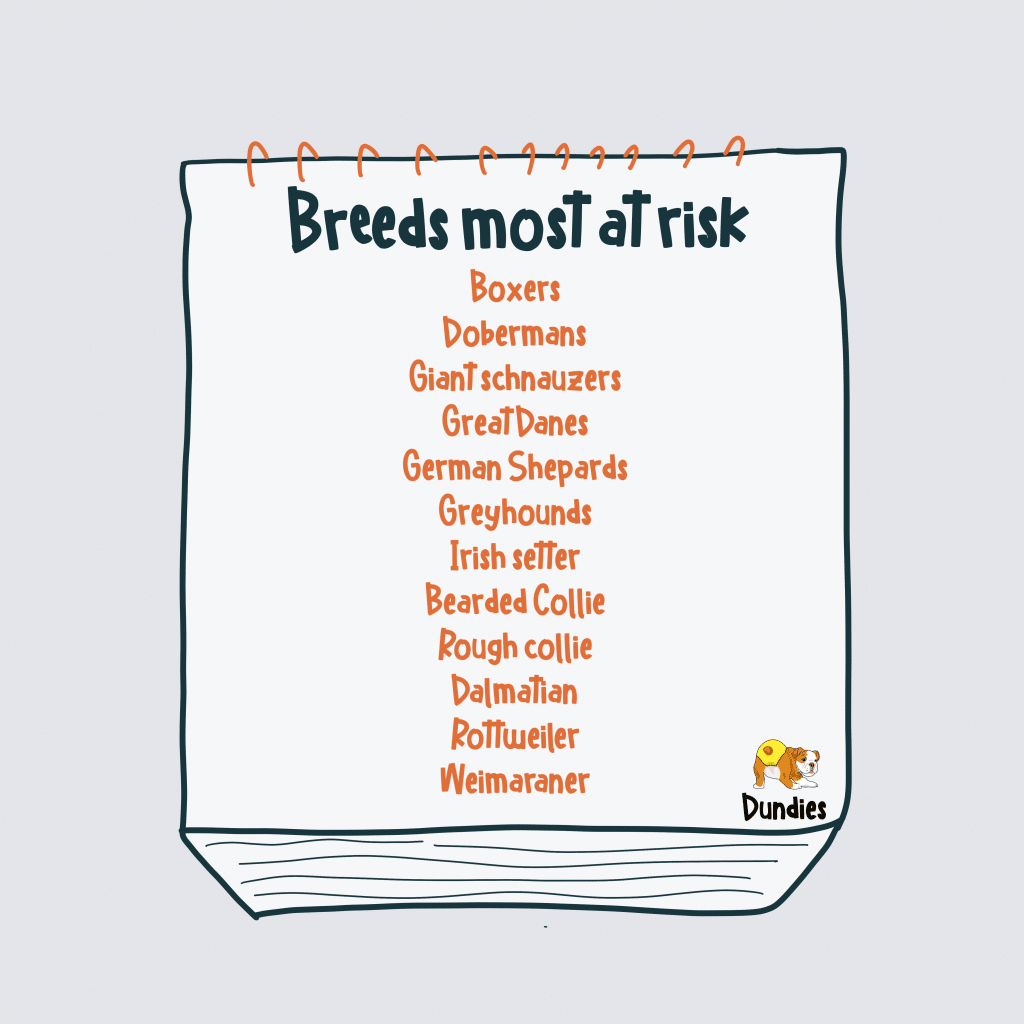
Incontinence in dogs, particularly urine incontinence is more common than you might think. It is estimated that 20% of desexed female dogs will develop incontinence at some point in their life. In this article we cover all the important details you need to know about what urine incontinence is, what causes it, what dogs are at risk of developing the condition and how it can be treated or managed. As with all Dundies blogs, this information is not a substitute for veterinary care, and if you have concerns with your dog or think they may be incontinent, it’s always best to check in with your vet.

What is Urinary Incontinence in Dogs?
Urinary incontinence is the involuntary loss of urine from your dog’s bladder. The severity and how much urine is lost by a dog who is suffering from incontinence can vary from small drops to a complete emptying of the bladder. It is important to remember that incontinence is usually caused by an underlying medical issue and your dog is unlikely to be aware that it is happening. Urine incontinence is separate from behaviour related urination concerns such as marking or anxiety.
How Do I Know if My Dog Has Incontinence?
The signs and symptoms of urine incontinence
The most visible sign that a dog may be suffering from urine incontinence is that they are dripping urine. Pets suffering incontinence can have an odour of ammonia or a red irritated rash on their hind legs, but you might also notice these changes in your dog:
- Excessive licking of the vulva or penis
- Finding wet patches where your dog has been sleeping
- The trickling of urine when they sit
- Involuntary loss of urine while running or exercising
- Dribbling of urine after the dog has been to the toilet
If your dog is displaying any of these symptoms, you should book into your veterinarian to have your dog’s health checked. Incontinence is usually caused by an underlying condition. A veterinarian will work with you to identify any underlying causes to treat your dog's incontinence. It can be helpful to take notes and bring them to a vet appointment. Click HERE to download our free printable incontinence checklist to fill out and take into your vet.
What Causes Incontinence in Dogs?
The different types of incontinence and their causes
Incontinence can arise from a variety of different conditions or underlying factors. It is important to understand these factors as the treatments and management of the urinary incontinence will differ for each.
Hormone Imbalance & Spay Incontinence
This is the most frequent type of incontinence in vet clinics and can be referred to as Hormone Responsive Incontinence or Urethral Sphincter Incompetence. It can occur in both male and female dogs but it is more common in middle-aged desexed female dogs. When a dog is desexed at a young age, the reproductive organs, the ovaries and uterus, are removed. These organs are responsible for the production of reproductive hormones such as oestrogen. For some dogs, the lack of hormones eventually results in weakness of the bladder sphincter muscles and can cause incontinence. It is important to know that the risk of developing this condition does not outweigh the benefit of having your dog desexed. Your vet might take a blood test to check your dog’s hormone levels to diagnose this type of incontinence.

Urinary Tract Infections
If left untreated, a urinary tract infection (UTI) can lead to incontinence. If you notice discharge from your dog’s vulva or penis, trouble urinating or frequent urination, book into your vet. They will conduct a urinalysis or urine culture to test your dog’s urine for any bacteria. If your dog has a UTI, your vet may prescribe antibiotics and once the infection clears, your dog’s incontinence may resolve.

Bladder Stones
Bladder stones can cause dysfunction to the way your dog stores urine in their bladder. This causes the bladder to contract frequently resulting in small amounts of urine leakage. This condition can be painful for a dog and they may display discomfort when they are trying to empty their bladder. This leads us into the next cause of incontinence in dogs, old age.
Weakened Bladder & Urethra Muscles in Old Age
Bladder leaks are not uncommon in older dogs. When a pet ages, their bladder and urethra muscles can weaken, so they might have a harder time holding in their urine. A senior dog may show signs of trying to get out to use the bathroom but have an accident before they get to the door.
Obesity can exaggerate any concerns with weak muscles so it's important to look after your dogs weight when dealing with incontinence.

Spinal Degeneration and Injury
Injury to the spine can cause disruption to the nerves that run down a dog’s back and control the bladder resulting in incontinence. Disruption of the nerves can be caused by brain diseases, neurological issues or lesions. Injury to the spine can result from car accidents, IVDD (Intervertebral Disk Disease) and other spinal health issues. This type of incontinence is usually only able to be managed and not cured.
Birth and Anatomical Abnormalities
Ectopic ureters are the most common birth defect that causes urinary incontinence. The ureters carry the urine from the kidneys to the bladder, however in this deformity they connect in an usual location such as the urethra, vagina or penis. This may cause urine dripping. Sometimes ectopic ureters can be surgically corrected. Other birth defects can cause incontinence such a Spina Bifida, urethral hypoplasia or unusual pelvic conformation.
Medications and Health Diseases
Corticosteroid medication, and other diseases such as diabetes, Cushing’s disease and kidney disease can all cause increased water intake by your dog. After a while you may notice your dog starting to develop incontinence when on medications or if they suffer from one of these diseases.

What Puts a Dog at Risk of Developing Incontinence?
Any dog of any age or gender can develop incontinence but some are at a greater risk than others.
Gender, Age and Desexed
- Female middle-aged dogs who have been desexed
- Female dogs greater than 20kg
- Senior Dogs
Breed risk

- Siberian Husky
- Miniature Poodle
- Labrador
- Collie
- Corgi
- Fox Terrier
- Highland Terrier
- German Shepard
- Rottweiler
- Doberman
- Springer Spaniel
- Weimaraner
- Dalmatians
- Boxers

How Can Dog Incontinence Be Treated and Managed?
Every form of incontinence has slightly different treatment or management plans.

Hormone Supplementation
If your dog’s incontinence is deemed to be caused by a hormone imbalance, your vet may recommend trying hormone therapy. Oestrogen based medications may be prescribed with the hopes of increasing the tone of the bladder muscles to reduce incontinence. It is important to discuss the side effects and effectiveness rate of these medications with your vet. Dogs who are on this form of medication will likely need to take them for the remainder of their life.
Surgery
In cases where your dog’s incontinence is caused by bladder stones or birth deformities, your vet may recommend a surgical treatment. Surgical treatments can be very effective in resolving incontinence related to ectopic ureters.
Management
Where incontinence cannot be cured with hormone therapy or surgery, your vet can help you form a management plan. It does not have to be a death sentence. You can implement these strategies at home to help keep your pet comfortable and your home hygienic:
- Using pet nappies designed for incontinence. Here at Dundies, we have a great range of All-in-One nappies and Belly bands. Regardless of what brand you choose, it’s important to make sure they are medical grade and safe. You can read more about what to look for in a dog nappy HERE.
- More frequent walks or trips outside.
- Using waterproof bedding. Dundies Puppy Pads are great for covering beds and couches.
- Maintaining good hygiene for your dog. If your dog has a long coat you may choose to give them a sanitary groom to prevent skin rashes and provide them regular baths.
- Allowing your dog plenty of outdoor time.
- Provide a mesh material trampoline bed.
There is a risk that urine incontinence can lead to the development of a UTI. Develop a plan with your vet about using supplements and putting a treatment plan in place to help maintain a healthy bladder for your dog.

